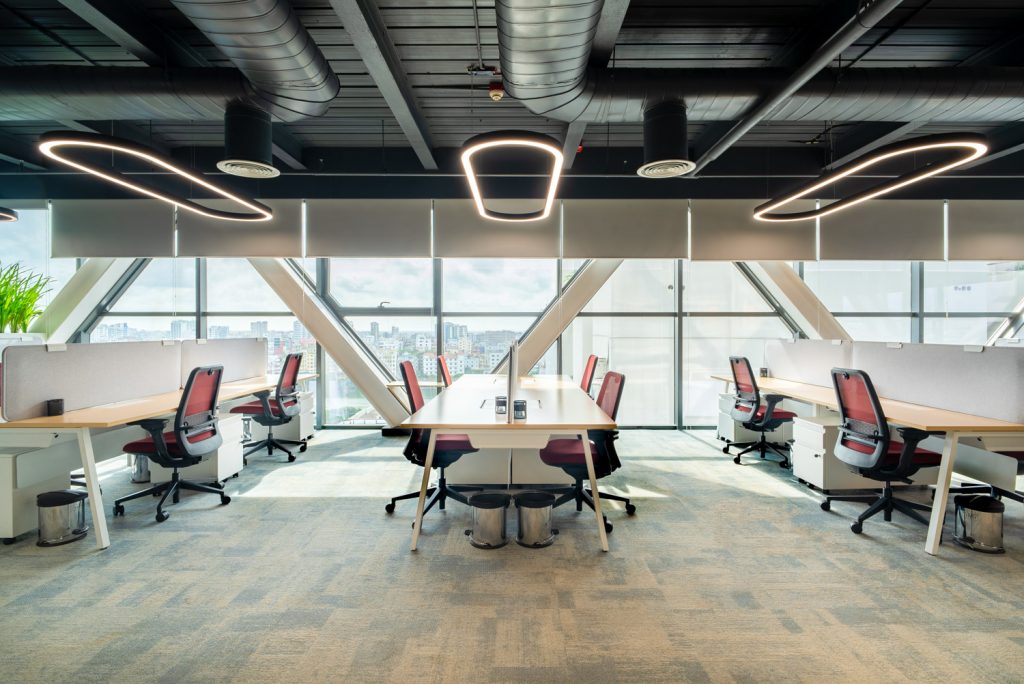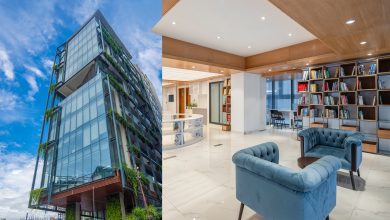Perched on the 11th floor of The Glass House on Gulshan Avenue, Oracle’s new 2,900-square-foot office in Dhaka redefines what a modern corporate workspace can be. Designed by Principal Architect Mamun Ar Rashid with Yasmin Akter Liza, and visualized by Nasirul Islam Tonmoy, the project translates Oracle’s global design ethos into a distinctly local architectural language. This is not just an office—it is a dynamic environment shaped around innovation, connectivity, and the human experience.

From the moment one steps through the glass doors, the space exudes precision and clarity. The reception area sets the tone with its bold teal-blue wall bearing the illuminated Oracle logo—a crisp expression of brand identity against a rich, confident hue. A sleek white reception desk grounds the composition, softened by cascading greenery that immediately introduces the project’s biophilic spirit. Behind, a frosted glass wall features Oracle’s signature fingerprint cloud motif, an abstract symbol of technology and identity that connects the company’s digital universe with the tactile world of design.
This design interplay—between technological edge and natural softness—runs through the entire office. Warm wood flooring meets fabric acoustic ceilings, while glass partitions ensure both transparency and privacy. The careful selection of textures and tones conveys the design team’s core philosophy: a space that looks modern, feels comfortable, and performs intelligently.
Color plays a defining role in articulating Oracle’s global presence. The teal-blue backdrop serves as the dominant visual anchor—bold yet calming—balanced by soft greys, warm wood grains, and strategic pops of yellow and green. These accent tones, found in lounge furniture and plant life, inject optimism and warmth into the environment.

Lighting, too, is integral to the composition. Custom LED rings and geometric fixtures carve through the ceiling, evoking the flow of data networks while serving a human purpose: comfort. Linear task lights provide even illumination across workstations, while indirect ambient lighting in collaboration zones creates a relaxed, engaging atmosphere. The result is a workspace that feels alive throughout the day—bright and alert in the mornings, calm and focused as evening descends.
The design unfolds through a deliberate sequence of zones—each with a distinct spatial identity yet connected through visual continuity.

At the reception and welcome area, natural light pours in from large glazed openings, reflecting off the teal walls and accentuating the crisp geometry of the furniture. Visitors are immediately met with a sense of openness and professionalism.
Moving deeper into the office, the open-plan workstation zone embodies efficiency and clarity. Linear desks, ergonomic chairs, and soft acoustic panels define an orderly rhythm, while natural light filters in from expansive windows overlooking Dhaka’s skyline. The placement of indoor plants along partitions softens the orthogonal grid, introducing a natural counterbalance to the space’s technological precision.
Beyond the formal workspace, the architects have carved out collaboration and lounge areas that celebrate flexibility and movement. Here, mustard-yellow armchairs and teal sofas sit beneath a ceiling lined with multicolored acoustic baffles. These suspended panels, while functional in controlling sound, also add visual dynamism—creating a sculptural canopy that mirrors Oracle’s innovation-driven identity.

In contrast, the breakout spaces and pods embrace informality and creativity. Designed as flexible nooks for brainstorming or quiet reflection, they foster the kind of spontaneous interactions essential to modern work culture. This diversity of settings—open, semi-private, and intimate—reflects the contemporary understanding that productivity thrives in environments adaptable to multiple work modes.
Every surface in the Oracle Dhaka office serves both aesthetic and functional roles. Wood finishes on the floor and furniture infuse warmth and familiarity, grounding the high-tech ambience in tactile comfort. Fabric acoustic panels lend softness while enhancing sound quality—a crucial consideration in open offices. The glass partitions etched with abstract patterns strike a balance between openness and confidentiality, visually connecting spaces while preserving focus.
The architects’ choice of materials is also a statement on sustainability. By favoring long-lasting, locally available finishes and optimizing natural light to reduce artificial illumination, the project subtly aligns with Oracle’s global commitment to environmental responsibility.

What distinguishes this office most is its sense of human connection. Plants are not decorative afterthoughts but integral design elements, placed thoughtfully across the layout to evoke calm and foster wellness. Lush greenery softens edges, frames vistas, and creates natural micro-breaks within the workspace. These living elements transform what could have been a strictly corporate environment into one that breathes—both literally and emotionally.
This integration of biophilic design with high-tech branding underscores the architects’ vision of a workplace where innovation and empathy coexist. It reflects a broader paradigm shift in office design—away from sterile efficiency and toward human-centric adaptability.
While unmistakably Oracle in its branding and precision, the project also carries traces of Dhaka’s evolving design sensibility. The architects have drawn from the city’s emerging contemporary vocabulary—fluid, layered, and context-aware—to create a space that feels global yet grounded. The balance of textures, the rhythm of the ceiling baffles, and the interplay between bold color and quiet neutrality all reveal a design maturity that bridges international standards and local nuance.
The Oracle Dhaka office ultimately embodies more than architectural finesse—it represents a spatial translation of the company’s ethos: innovation, collaboration, and human connection. Every design move, from the glowing ring lights to the touch of wood beneath one’s feet, reinforces that philosophy.
For architect Mamun Ar Rashid and his team, the success of the project lies not only in its visual coherence but in how it makes people feel. Employees walk into a space that is intelligent yet warm, efficient yet comfortable, high-performing yet deeply human.

In a city where workspaces are rapidly transforming, Oracle’s Dhaka office stands as a benchmark—an example of how thoughtful design can elevate corporate interiors into environments of inspiration, identity, and well-being. Here, the digital meets the tactile, the global meets the local, and architecture quietly amplifies the pulse of innovation.




